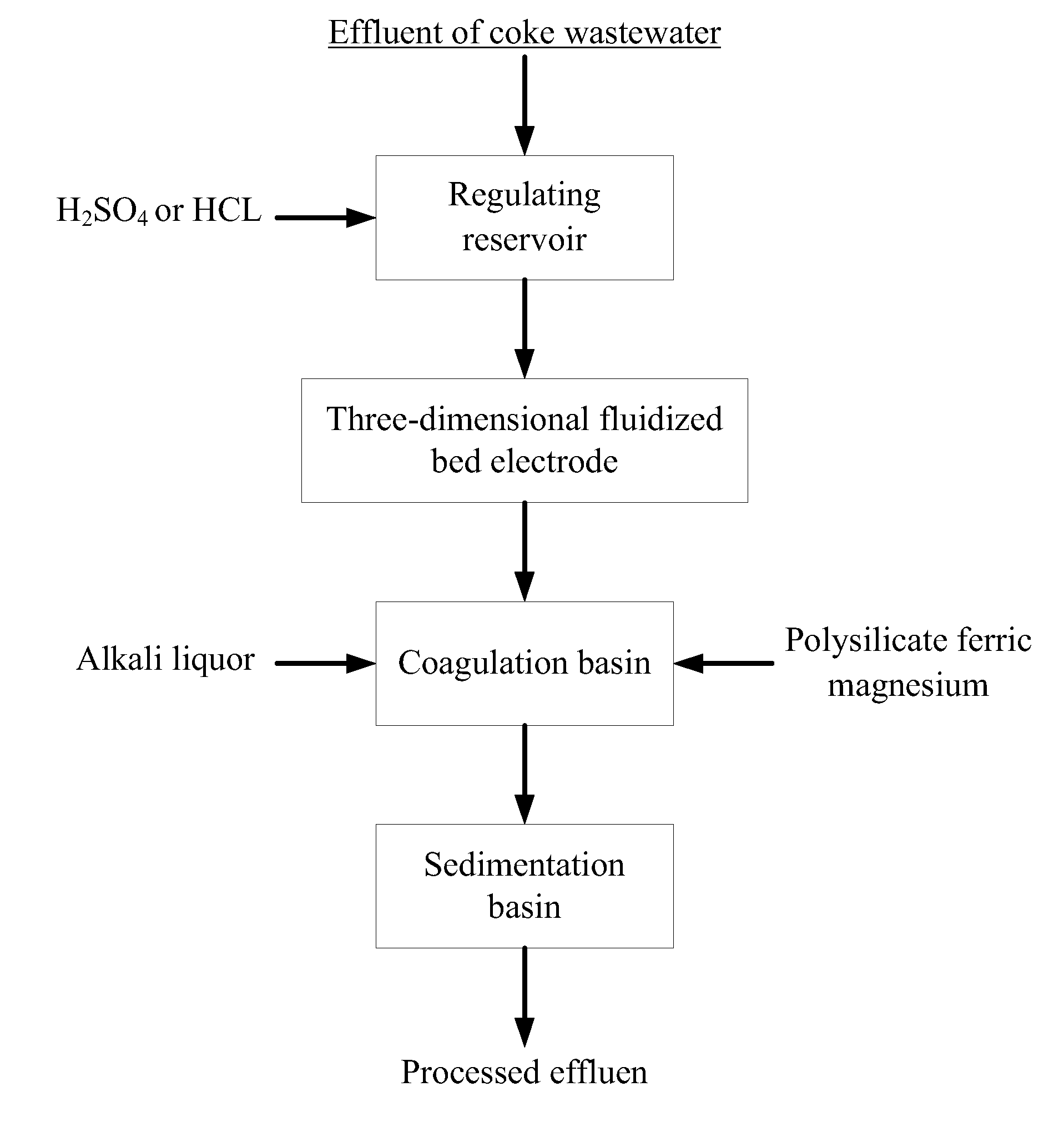Method of treatment of coke wastewater
a wastewater treatment and coke technology, applied in water/sewage multi-stage treatment, water/sewage treatment by neutralisation, separation process, etc., can solve the problems of low treatment efficiency, difficult microbial growth, and inability to achieve cod emission standards, etc., and achieve the effect of reducing environmental pollution
- Summary
- Abstract
- Description
- Claims
- Application Information
AI Technical Summary
Benefits of technology
Problems solved by technology
Method used
Image
Examples
example 1
Preparation of a Coagulant of Polysilicate Ferric Magnesium
[0023]Polysilicate ferric magnesium is made from industrial water glass in which the content of SiO2 is 2.5%; sulfuric acid is added until the pH value of the industrial water glass is 5.2; after activation for 30 mins under a constant temperature of 45° C., quantitative ferric sulfate and magnesium chloride are added, molar ratio of Si / (Fe+Mg) is 0.7, and molar ratio of Fe / Mg is 2.0, then it is stirred until full dissolution and cured for 2 hours; in this way, polysilicate ferric magnesium can be obtained.
[0024]Wastewater not up to standard is disposed by a coking plant with a biochemical treatment process, COD ranging from 128 mg / L to 165 mg / L, ammonia nitrogen ranging from 19 mg / L to 32 mg / L, and chroma being 150 times; effluent which has been through biochemical treatment is led to a regulating reservoir into which sulfuric acid (H2SO4) solution is added until the pH value of wastewater is 5.5; then wastewater is led to ...
example 2
Preparation of a Coagulant of Polysilicate Ferric Magnesium
[0026]Polysilicate ferric magnesium is made from industrial water glass in which the content of SiO2 is 3%; sulfuric acid is added until the pH value of the industrial water glass is 5; after activation for 30 mins under a constant temperature of 50° C., quantitative ferric sulfate and magnesium sulfate are added, molar ratio of Si / (Fe+Mg) is 0.5, and molar ratio of Fe / Mg is 1, then it is stirred until full dissolution and cured for 2 hours; in this way, polysilicate ferric magnesium can be obtained.
[0027]Wastewater not up to standard is disposed by a coking plant with a biochemical treatment process, COD ranging from 210 mg / L to 305 mg / L, ammonia nitrogen ranging from 30 mg / L to 50 mg / L, and chroma being 300 times; effluent which has been through biochemical treatment is led to a regulating reservoir into which hydrochloric acid (HCL) solution is added until the pH value of wastewater is 6; then wastewater is led to a self-...
example 3
Preparation of a Coagulant of Polysilicate Ferric Magnesium
[0029]Polysilicate ferric magnesium is made from industrial water glass in which the content of SiO2 is 4%; sulfuric acid is added until the pH value of the industrial water glass is 4.8; after activation for 30 mins under a constant temperature of 45° C., quantitative ferric chloride and magnesium sulfate are added, molar ratio of Si / (Fe+Mg) is 1.2, and molar ratio of Fe / Mg is 0.8, then it is stirred until full dissolution and cured for 2 hours; in this way, polysilicate ferric magnesium can be obtained.
[0030]Wastewater not up to standard is disposed by a coking plant with a biochemical treatment process, COD ranging from 180 mg / L to 272 mg / L, ammonia nitrogen ranging from 12 mg / L to 28 mg / L, and chroma being 320 times; effluent which has been through biochemical treatment is led to a regulating reservoir into which sulfuric acid (H2SO4) solution is added until the pH value of wastewater is 6; then wastewater is led to a se...
PUM
| Property | Measurement | Unit |
|---|---|---|
| particle size | aaaaa | aaaaa |
| constant temperature | aaaaa | aaaaa |
| molar ratio | aaaaa | aaaaa |
Abstract
Description
Claims
Application Information
 Login to View More
Login to View More - R&D
- Intellectual Property
- Life Sciences
- Materials
- Tech Scout
- Unparalleled Data Quality
- Higher Quality Content
- 60% Fewer Hallucinations
Browse by: Latest US Patents, China's latest patents, Technical Efficacy Thesaurus, Application Domain, Technology Topic, Popular Technical Reports.
© 2025 PatSnap. All rights reserved.Legal|Privacy policy|Modern Slavery Act Transparency Statement|Sitemap|About US| Contact US: help@patsnap.com


